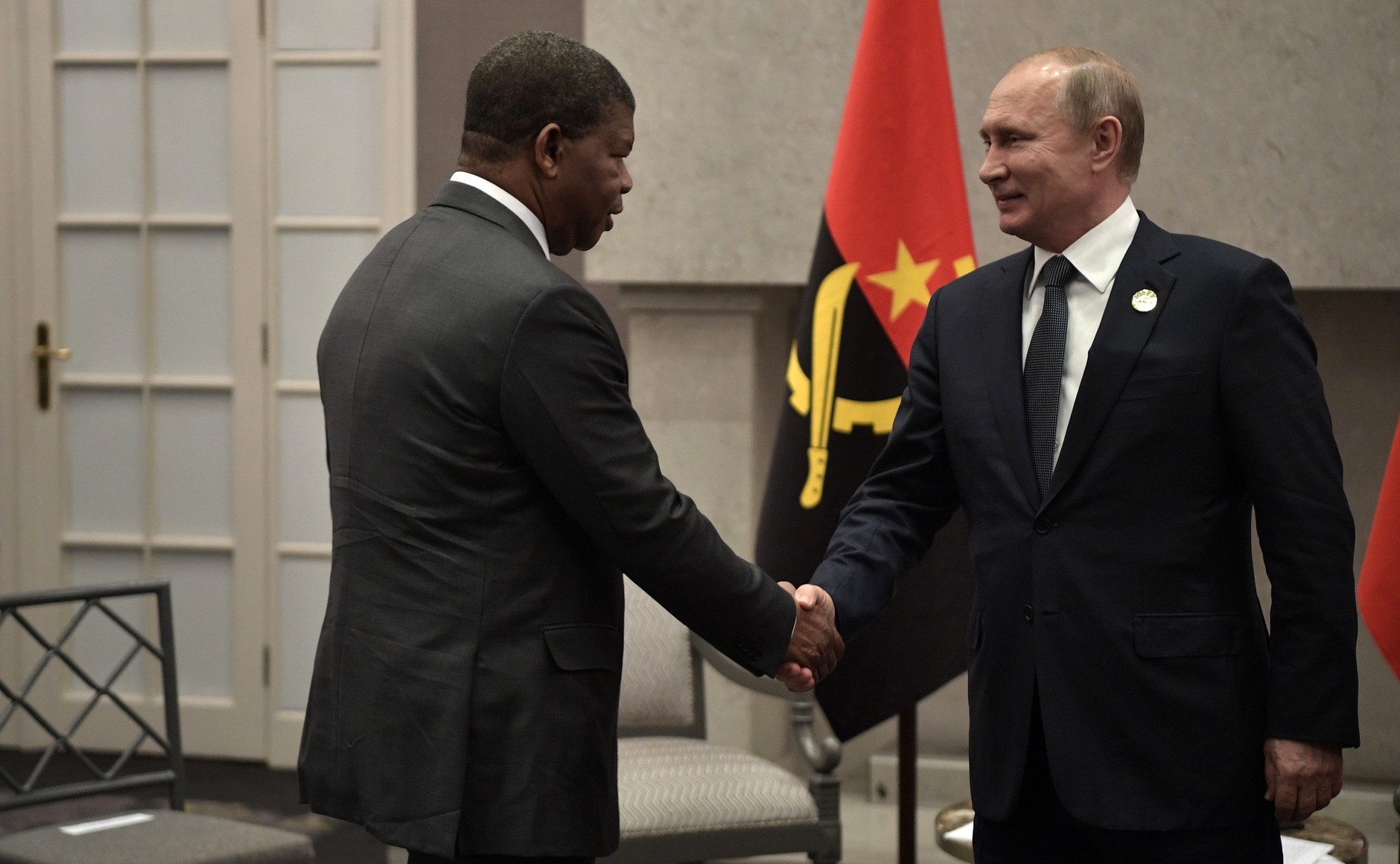World
Angola Mulls Manufacturing Russian Military Equipment

By Kester Kenn Klomegah
As it was, indeed, looking for profitable business, investment and trade rather than development aid, Angola, a south-central African republic, announced corporate plans to diversify its state business away from purchasing to fully-fledged manufacturing of Russian military equipment for the southern African market, and most possible other regions in Africa.
While heading a delegation for a four-day visit from April 2-5 on an invitation from the Kremlin, President João Lourenço, said in an exclusive interview with the local Russian media, Itar-TASS, that Angola is one of the principal buyers of Russian arms and his country wants, not only buy but also to produce them, – outlining the government’s grandiose plan.
“As for our military and technical cooperation with Russia – it will continue and be deepened. We would like to evolve from our current state of purchasers of Russian military equipment and technologies towards becoming the manufacturers and having an assembly plant of Russian military equipment in our country,” he told the news agency.
Although this was the Angolan leader’s first official visit to Russia in this capacity, he has first-hand knowledge about the Russian capital, since he studied at the Military-Political Academy in 1978-1982.
Russian Defense Ministry and Rosoboronexport have made no official comment on the alleged deals, but local Russian financial newspaper Vedomosti said, in essence, such highly military deal with Angola could offer Russia a conduit to the southern region and would cement its position as a controlling super power in the weaponry market.
Over the years, Russia has made “military-technical cooperation” as an important part of its foreign policy objectives with Africa. According to Angola’s Defense Minister Salviano de Jesus Sequeira, Russia has already delivered six SU-30K fighter jets to Angola this year and two more are expected by the end of May.
Besides, Sequeira said the country is interested in buying Russian S-400 air-defense systems, but there is no talks because of economic difficulties, and only adding that “Angolan armed forces are used to work with Russian weapons” because of that the military cooperation between the two countries will last forever.
According to Ministry of Defense website report, Russia agreed to supply arms and military equipment to Angola worth US$2.5 billion, including spare parts for the Soviet-made weaponry, light weapons, ammunition, tanks, artillery and multi-purpose helicopters.
In a research report titled “Angola: Russia and Angola – the Rebirth of a Strategic Partnership” that was released by the South African Institute of International Affairs (SAIIA), the authors Ana Christina Alves, Alexandra Arkhangelskaya and Vladimir Shubin acknowledged that “defense remains the most solid Russia-Angolan cooperation dimension. To date, Russia is Angola’s most strategic military partner.”
Ana Christina Alves, a Senior Researcher at the Global Powers and Africa Programme, South African Institute of International Affairs (SAIIA), explained further to me that “the military equipment is, undoubtedly, the largest and most profitable side of Russia’s trade with Africa – which the figures unfortunately don’t feature in official bilateral trade data. If these were included, the bilateral trade volume would appear much more impressive. This is, perhaps, the strongest dimension of Russia’s dealings in Africa at present, but because of the nature of the business very little is known outside military circles, so hard to get the actual picture.”
“Of course, it is better and cheaper to have such armaments assembled in Angola than purchasing ready-made ones directly from Russia. It will enable technology transfer and improve the technical knowledge and experience of Angolans while possibly turning that country into a getaway for Russian arms and military equipment to the wider central and southern African region,” Professor Shaabani Nzori, Expert on foreign policy based in Moscow, told me in the interview discussion.
It would help Russia gain fully-fledged foothold in that market for its military industry, one of the few comparative advantages that Russia currently has over other arms’ producing countries. So, it is a win-win situation for both these two countries, he added assertively.
On the other hand, concerning trafficking and proliferation of Russian arms in Africa as a result of such cooperation between Russia and Angola, even without them at the moment, Russian, American, Chinese, European, North Korean, Iranian, Israeli arms are already in abundance in continent. But it’s expected that the Russian-Angolan deal helps to mitigate, if not exclude altogether, such a development,” Shaabani further informed.
Military-technical cooperation has long been a priority area in bilateral ties, with the Soviet Union beginning to supply weapons for guerilla units back in the 1960s, Andrei Tokarev, Head of the Center for Southern African Studies at the Russian Academy of Sciences, told Kommersant, a local Russian financial daily newspaper.
“However, with the fall of the apartheid regime in neighboring South Africa in 1994 and the end of the civil war in 2002, Angola has no potential enemies, so the need for arms supplies has dwindled. In recent years, Angola’s leadership has had plans to turn the country into a base to repair Soviet equipment for African countries. For its part, South Africa had similar business ideas as well. One cannot rule out that the proposal to both purchase and produce (manufacture) weapons as an attempt to outmaneuver South Africa, but the local industry is not yet ready to manufacture its own military equipment,” explained Andrei Tokarev.
Foreign experts have also expressed their concern. Professor Alex Vines, Head of the Africa Programme at Chatham House, and recently served as a member of the Commonwealth Observer Group to Ghana in 2016 and a UN election officer in Mozambique and Angola, in an emailed discussion acknowledged Russia’s military-technical cooperation with African countries.
He wrote from London that “the Angolan military partnership with Russia has been tight for many years and a significant part of the procurement through its Simportex is with Russia. This continues as Russia delivered six SU-30K fighter jets this year and is interested in procuring a Russian S-400 air defense system. The new development is seeking a partnership with Russia for manufacturing defense equipment in Angola. Russia has a series of maintenance facilities in Africa for after sales – but this would be a significant development.”
Furthermore, he said assertively that his own experience of Angola, including being a UN sanctions inspector, “is that Angolan arsenals have not been a major problem for theft, but the biggest concern was the sale of old weapons and munitions from stores to independent brokers who then sold the equipment onto sanctioned entities.”
Professor David Shinn at the Elliott School of International Affairs, George Washington University, and a former U.S. Ambassador to Ethiopia (1996-99) and Burkina Faso (1987-90), wrote in an email interview that with the latest development, particularly, SU-30K aircraft purchased by Angola, one has to ask why Angola needs such a high performance fighter aircraft and who is the potential enemy?
Undoubtedly, Russia might have proposed to help Angola develop a weapon’s manufacturing capacity, obviously drawing on Russian designs and weapons. If this assumption is correct, it therefore means that Angola will join a growing list of countries in Africa that have their own internal weapons manufacturing.
In this regard, Shinn added that South Africa has the most advanced capacity to produce military equipment followed by Egypt. Sudan, which received assistance from China and Iran in building its arms industry, and Nigeria, among others, also have the ability to produce military equipment. In this sense, what Angola proposed to do (that is to establish manufacturing plant) is not much different except that it would, reportedly, be assisted by the Russian Federation.
“Weapons produced by any country can and do appear in African conflict zones. There is plenty of documentation, for example, that weapons made in China, Russia, and Western countries are being used in ongoing conflicts in Darfur, the eastern Congo, and Somalia. In some cases, African governments have transferred the arms to rebel groups and many others have been purchased on the international arms market,” he said.
According to Professor Shinn, the SADC countries, with the notable exception of the Democratic Republic of the Congo, have avoided major conflict in recent years. As a result, the movement of arms to rebel groups has not been an issue.
Professor Shinn concluded: “Should Angola become a key producer and distributor of Russian arms, there is always the possibility some of them could eventually appear outside Angola in the SADC region. One would hope this initiative must necessarily be approved by the Angolan parliament, and be of great interest for SADC, the African Union and Security Council of the United Nations.”
Kester Kenn Klomegah writes frequently about Russia, Africa and the BRICS.
World
Russian-Nigerian Economic Diplomacy: Ajeokuta Symbolises Russia’s Remarkable Achievement in Nigeria

By Kestér Kenn Klomegâh
Over the past two decades, Russia’s economic influence in Africa—and specifically in Nigeria—has been limited, largely due to a lack of structured financial support from Russian policy banks and state-backed investment mechanisms. While Russian companies have demonstrated readiness to invest and compete with global players, they consistently cite insufficient government financial guarantees as a key constraint.
Unlike China, India, Japan, and the United States—which have provided billions in concessionary loans and credit lines to support African infrastructure, agriculture, manufacturing, and SMEs—Russia has struggled to translate diplomatic goodwill into substantial economic projects. For example, Nigeria’s trade with Russia accounts for barely 1% of total trade volume, while China and the U.S. dominate at over 15% and 10% respectively in the last decade. This disparity highlights the challenges Russia faces in converting agreements into actionable investment.
Lessons from Nigeria’s Past
The limited impact of Russian economic diplomacy echoes Nigeria’s own history of unfulfilled agreements during former President Olusegun Obasanjo’s administration. Over the past 20 years, ambitious energy, transport, and industrial initiatives signed with foreign partners—including Russia—often stalled or produced minimal results. In many cases, projects were approved in principle, but funding shortfalls, bureaucratic hurdles, and weak follow-through left them unimplemented. Nothing monumental emerged from these agreements, underscoring the importance of financial backing and sustained commitment.
China as a Model
Policy experts point to China’s systematic approach to African investments as a blueprint for Russia. Chinese state policy banks underwrite projects, de-risk investments, and provide finance often secured by African sovereign guarantees. This approach has enabled Chinese companies to execute large-scale infrastructure efficiently, expanding their presence across sectors while simultaneously investing in human capital.
Egyptian Professor Mohamed Chtatou at the International University of Rabat and Mohammed V University in Rabat, Morocco, argues: “Russia could replicate such mechanisms to ensure companies operate with financial backing and risk mitigation, rather than relying solely on bilateral agreements or political connections.”
Russia’s Current Footprint in Africa
Russia’s economic engagement in Africa is heavily tied to natural resources and military equipment. In Zimbabwe, platinum rights and diamond projects were exchanged for fuel or fighter jets. Nearly half of Russian arms exports to Africa are concentrated in countries like Nigeria, Zimbabwe, and Mozambique. Large-scale initiatives, such as the planned $10 billion nuclear plant in Zambia, have stalled due to a lack of Russian financial commitment, despite completed feasibility studies. Similar delays have affected nuclear projects in South Africa, Rwanda, and Egypt.
Federation Council Chairperson Valentina Matviyenko and Senator Igor Morozov have emphasized parliamentary diplomacy and the creation of new financial instruments, such as investment funds under the Russian Export Center, to provide structured support for businesses and enhance trade cooperation. These measures are designed to address historical gaps in financing and ensure that agreements lead to tangible outcomes.
Opportunities and Challenges
Analysts highlight a fundamental challenge: Russia’s limited incentives in Africa. While China invests to secure resources and export markets, Russia lacks comparable commercial drivers. Russian companies possess technological and industrial capabilities, but without sufficient financial support, large-scale projects remain aspirational rather than executable.
The historic Russia-Africa Summits in Sochi and in St. Petersburg explicitly indicate a renewed push to deepen engagement, particularly in the economic sectors. President Vladimir Putin has set a goal to raise Russia-Africa trade from $20 billion to $40 billion over the next few years. However, compared to Asian, European, and American investors, Russia still lags significantly. UNCTAD data shows that the top investors in Africa are the Netherlands, France, the UK, the United States, and China—countries that combine capital support with strategic deployment.
In Nigeria, agreements with Russian firms over energy and industrial projects have yielded little measurable progress. Over 20 years, major deals signed during Obasanjo’s administration and renewed under subsequent governments often stalled at the financing stage. The lesson is clear: political agreements alone are insufficient without structured investment and follow-through.
Strategic Recommendations
For Russia to expand its economic influence in Africa, analysts recommend:
- Structured financial support: Establishing state-backed credit lines, policy bank guarantees, and investment funds to reduce project risks.
- Incentive realignment: Identifying sectors where Russian expertise aligns with African needs, including energy, industrial technology, and infrastructure.
- Sustained implementation: Turning signed agreements into tangible projects with clear timelines and milestones, avoiding the pitfalls of unfulfilled past agreements.
With proper financial backing, Russia can leverage its technological capabilities to diversify beyond arms sales and resource-linked deals, enhancing trade, industrial, and technological cooperation across Africa.
Conclusion
Russia’s Africa strategy remains a work in progress. Nigeria’s experience with decades of agreements that failed to materialize underscores the importance of structured financial commitments and persistent follow-through. Without these, Russia risks remaining a peripheral player (virtual investor) while Arab States such as UAE, China, the United States, and other global powers consolidate their presence.
The potential is evident: Africa is a fast-growing market with vast natural resources, infrastructure needs, and a young, ambitious population. Russia’s challenge—and opportunity—is to match diplomatic efforts with financial strategy, turning political ties into lasting economic influence.
World
Afreximbank Warns African Governments On Deep Split in Global Commodities

By Adedapo Adesanya
Africa Export-Import Bank (Afreximbank) has urged African governments to lean into structural tailwinds, warning that the global commodity landscape has entered a new phase of deepening split.
In its November 2025 commodity bulletin, the bank noted that markets are no longer moving in unison; instead, some are powered by structural demand while others are weakening under oversupply, shifting consumption patterns and weather-related dynamics.
As a result of this bifurcation, the Cairo-based lender tasked policymakers on the continent to manage supply-chain vulnerabilities and diversify beyond the commodity-export model.
The report highlights that commodities linked to energy transition, infrastructure development and geopolitical realignments are gaining momentum.
For instance, natural gas has risen sharply from 2024 levels, supported by colder-season heating needs, export disruptions around the Red Sea and tightening global supply. Lithium continues to surge on strong demand from electric-vehicle and battery-storage sectors, with growth projections of up to 45 per cent in 2026. Aluminium is approaching multi-year highs amid strong construction and automotive activity and smelter-level power constraints, while soybeans are benefiting from sustained Chinese purchases and adverse weather concerns in South America.
Even crude oil, which accounts for Nigeria’s highest foreign exchange earnings, though still lower year-on-year, is stabilising around $60 per barrel as geopolitical supply risks, including drone attacks on Russian facilities, offset muted global demand.
In contrast, several commodities that recently experienced strong rallies are now softening.
The bank noted that cocoa prices are retreating from record highs as West African crop prospects improve and inventories recover. Palm oil markets face oversupply in Southeast Asia and subdued demand from India and China, pushing stocks to multi-year highs. Sugar is weakening under expectations of a nearly two-million-tonne global surplus for the 2025/26 season, while platinum and silver are seeing headwinds from weaker industrial demand, investor profit-taking and hawkish monetary signals.
For Africa, the bank stresses that the implications are clear. Countries aligned with energy-transition metals and infrastructure-linked commodities stand to benefit from more resilient long-term demand.
It urged those heavily exposed to softening agricultural markets to accelerate a shift into processing, value addition and product diversification.
The bulletin also called for stronger market-intelligence systems, improved intra-African trade connectivity, and investment in logistics and regulatory capacity, noting that Africa’s competitiveness will depend on how quickly governments adapt to the new two-speed global environment.
World
Aduna, Comviva to Accelerate Network APIs Monetization

By Modupe Gbadeyanka
A strategic partnership designed to accelerate worldwide enterprise adoption and monetisation of Network APIs has been entered into between Comviva and the global aggregator of standardised network APIs, Aduna.
The adoption would be done through Comviva’s flagship SaaS-based platform for programmable communications and network intelligence, NGAGE.ai.
The partnership combines Comviva’s NGAGE.ai platform and enterprise onboarding expertise with Aduna’s global operator consortium.
This unified approach provides enterprises with secure, scalable access to network intelligence while enabling telcos to monetise network capabilities efficiently.
The collaboration is further strengthened by Comviva’s proven leadership in the global digital payments and digital lending ecosystem— sectors that will be among the biggest adopters of Network APIs.
The NGAGE.ai platform is already active across 40+ countries, integrated with 100+ operators, and processing over 250 billion transactions annually for more than 7,000 enterprise customers. With its extensive global deployment, NGAGE.ai is positioned as one of the most scalable and trusted platforms for API-led network intelligence adoption.
“As enterprises accelerate their shift toward real-time, intelligence-driven operations, Network APIs will become foundational to digital transformation. With NGAGE.ai and Aduna’s global ecosystem, we are creating a unified and scalable pathway for enterprises to adopt programmable communications at speed and at scale.
“This partnership strengthens our commitment to helping telcos monetise network intelligence while enabling enterprises to build differentiated, secure, and future-ready digital experiences,” the chief executive of Comviva, Mr Rajesh Chandiramani, stated.
Also, the chief executive of Aduna, Mr Anthony Bartolo, noted that, “The next wave of enterprise innovation will be powered by seamless access to network intelligence.
“By integrating Comviva’s NGAGE.ai platform with Aduna’s global federation of operators, we are enabling enterprises to innovate consistently across markets with standardised, high-performance Network APIs.
“This collaboration enhances the value chain for operators and gives enterprises the confidence and agility needed to launch new services, reduce fraud, and deliver more trustworthy customer experiences worldwide.”
-

 Feature/OPED6 years ago
Feature/OPED6 years agoDavos was Different this year
-
Travel/Tourism9 years ago
Lagos Seals Western Lodge Hotel In Ikorodu
-

 Showbiz3 years ago
Showbiz3 years agoEstranged Lover Releases Videos of Empress Njamah Bathing
-

 Banking7 years ago
Banking7 years agoSort Codes of GTBank Branches in Nigeria
-

 Economy3 years ago
Economy3 years agoSubsidy Removal: CNG at N130 Per Litre Cheaper Than Petrol—IPMAN
-

 Banking3 years ago
Banking3 years agoFirst Bank Announces Planned Downtime
-

 Banking3 years ago
Banking3 years agoSort Codes of UBA Branches in Nigeria
-

 Sports3 years ago
Sports3 years agoHighest Paid Nigerian Footballer – How Much Do Nigerian Footballers Earn











